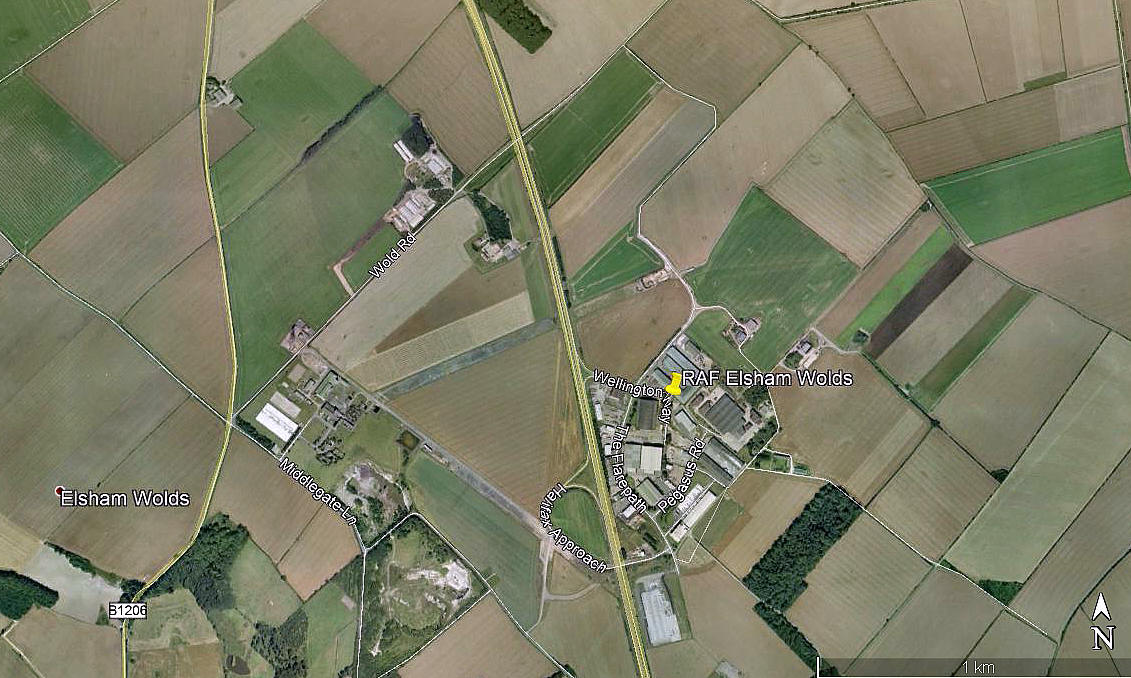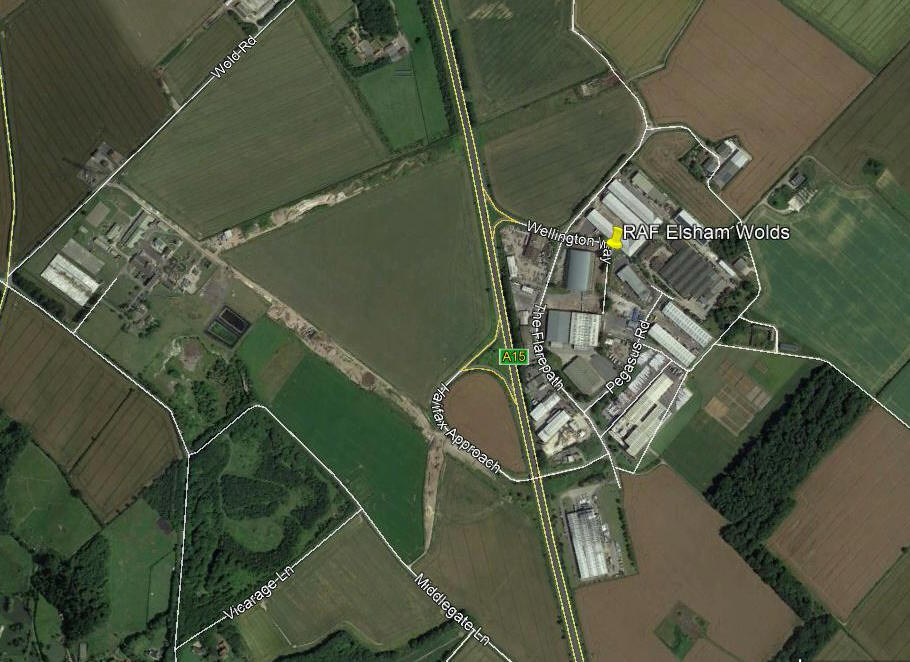Elsham Wolds
ELSHAM WOLDS: Military aerodrome (Aka ELSHAM in WW1)
Note: Both of these pictures were obtained from Google Earth ©
Military users: RFC/RAF (Royal Flying Corps / Royal Air Force)
33 [Home Defence] Sqdn (Royal Aircraft Factory BE.2s, FE.2s later Bristol F.2Bs)
Note: I am not sure which of these types they operated here. Probably not BE.2s?
WW2: RAF Bomber Command 1 Group
100 Sqdn (Avro Lancasters
103 Sqdn (Vickers Wellingtons, Handley Page Halifax and Avro Lancasters)
Post 1945: RAF Transport Command
21 HGCU (Heavy Glider Conversion Unit)
Location: NNE of Elsham village and straddling the A15, 5nm NNE of Brigg
Note: Today the A15 runs along runway 01/19. A very convenient source of hardcore perhaps - or did they just cover the existing runway? This was built in the 1970s.
Period of operation: 1941 to 1947
Runways: WW2: 01/19 1280x46 hard 07/25 1463x46 hard
13/31 1829x46 hard
NOTES: Here again yet another largely forgotten aerodrome but with 2068 RAF personnel on station in 1944.
SOME STATISTICS
Around 120,000 men served as aircrew in the RAF during WW2 and 55,733 lost their lives. Not just on operations, but in training and various accidents.It appears that around 8,000 aircrew were killed in training exercises, not just in the stages when they were 'learning their trade' but also in training exercises once with operational squadrons.
Added to this appalling number were those who suffered serious injuries which for many meant they were permanently disabled, and needless to say, there will never be reliable statistics for those who suffered to greater or lesser extent debilitating mental trauma.
After WW2 the RAF and officialdom went into denial for some reason which many regard, including myself, as being in part at least - irrational. Indeed, it was not until June 2012 that a memorial was finally erected to these men of Bomber Command, in central London. To put this into perspective, these survival rates are lower than those for the infantry officers serving in the trenches during WW1.
A FEW STATISTICS
ELSHAM WOLDS is credited with more operational sorties than any other airfield in 1 Group. During these operations 103 Squadron lost 28 Wellingtons, 12 Halifaxes and 208 Lancasters.
One Lancaster, ED888, (which also served with 576 Squadron), held the Bomber Command record for flying 140 sorties between May 1943 and December 1944, logging 974 operational hours. Why on earth wasn't that Lancaster preserved?
AN INTERESTING ASPECT
It seems of interest to note that, amongst the aircrew of 103 Squadron based here, there was Cy Grant, a 'coloured' man from British Guiana (now British Gyuana). His father was half-Scot and half-Barbadian and his mother was part East Indian. Another example was Bruce Fitzgerald Henry Miller from Barbados who also served with 103 Squadron. The Lancaster he was flying was shot down shortly after bombing Kassel, a raid in which some 10,000 civilians died. His aircraft exploded in mid-air after being attacked by a night fighter over Wesertal and all the crew were killed.
The British government officially lifted the colour bar for the armed services in October 1939, just eight weeks after WW2 commenced. However it appears that only the RAF put this into practice with over six thousand black and coloured people, from the Caribbean and West Africa volunteering for service in Europe.
Of these, about four hundred graduated to become aircrew and they were mostly regarded as being very good airmen, several serving with distinction. And, not just in Bomber Command, several became fighter pilots.
SOMETHING TO BE EXPLAINED
I might seem surprising that some one hundred were commissioned as officers and 251 attained the rank of sergeant or above because this is a well above average rate of achievement for any racial group in any society throughout the world. It can mostly be explained simply because these men were mostly very well educated and very highly motivated indeed.
Many years later some were accused, in the home countries, by ignorant younger people needless to say, of fighting in a 'white man's war'. Quite rightly they were incensed by such small-minded bigotry. Fortunately they had seen the bigger picture and realised that if the Nazi regime was allowed to succeed, they would in all likehood, revert to being slaves once again. And of course, having won that battle - to some extent at least - the last thing they wanted was to endure that again.
Is it not ironic then, that after the war was won, and British government agents toured the Caribbean urging those people to come to the UK to help with the recovery; when they arrived they invariably found the most severe form of racialist bigotry being foisted upon them. What a result! And of course we still suffer the long lasting effects even today, well into the 21st century.
For more information on this little known facet of the RAF during WW2 I can highly recommend reading Caribbean Volunteers At War by Mark Johnson.
SOME STATISTICS
Mark Johnson also tells us that; "A new RAF bomber crew on its first three missions were five times more likely to be killed than an experienced crew. With a five per cent loss rate per mission overall, this meant that new crews only had a forty per cent chance of surviving to fly their fourth mission. On a thirty mission tour, the statistical probabilty of death or capture was well above 100 per cent and RAF Bomber Command suffered , pro rata, the highest loss rate of any branch of the British Armed forces during the war, although as the war in Europe drew to a close in the Spring of 1945, losses did decline."
Faced with these prospects, for us today it must surely seem incredible that these aircrew members voluntarily climbed into their aircraft time and time again. However, most of them were very young, and at that age most of us have little concept regarding our own mortality, and of course they all knew very well indeed the incredible burden of responsibilty that had been placed upon them.
It is often overlooked in more recent times that they, and they alone, were the only means of taking the war to the German homeland, and this applied pretty much until 1944. And of course as a general rule, even after the D-Day offensive was slowly pushing the Germans back, it was still Bomber Command who, along with the USAAF needless to say, who performed this role.
A COMMENT
There are quite a lot people today, from all walks of life in many countries, that feel that the mass destruction of German towns and cities was totally unjustified, especially in the final two years. But, they either do not realise, or choose to ignore, that right up until the end the south east of England especially was being subjected to arguably the most fearsome weapons the world had ever seen up to that point. The V.1 and especially the devastating V.2 - and - they were being directed, almost entirely, onto a civil population.
Faced with this horrific scenario, there can never be any argument whatsover about the justification. Or, to put it very bluntly - every single bomb dropped on Germany was entirely justified.
We'd love to hear from you, so please scroll down to leave a comment!
Leave a comment ...
Copyright (c) UK Airfield Guide

















